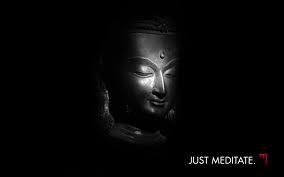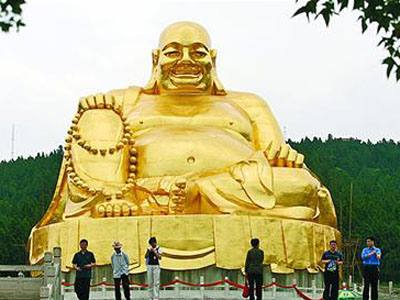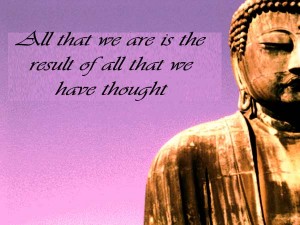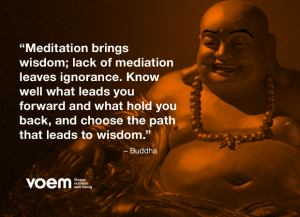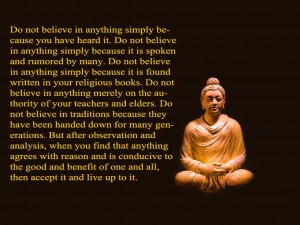The object of Buddhist meditation, however, is none of these things.
They arise as side-products, but not only are they not its goal, but
they are hindrances which have to be overcome. The Christian who has
seen Jesus, or the Hindu who has conversed with Bhagavan Krishna may be
quite satisfied that he has fulfilled the purpose of his religious life,
but the Buddhist who sees a vision of the Buddha knows by that very
fact that he has only succeeded in objectifying a concept in his own
mind, for the Buddha after his Parinibbana is, in his own words, no
longer visible to gods or men.
There is an essential difference, then, between Buddhist meditation
and concentration and that practiced in other systems. The Buddhist
embarking on a course of meditation does well to recognize this
difference and to establish in his own conscious mind a clear idea of
what it is he is trying to do.
The root-cause of rebirth and suffering is avijja conjoined with and reacting upon tanha.
These two causes form a vicious circle; on the one hand, concepts, the
result of ignorance, and on the other hand, desire arising from
concepts. The world of phenomena has no meaning beyond the meaning given
to it by our own interpretation.
When that interpretation is conditioned by avijja, we are subject to the state known as vipallasa, or hallucination. Sañña-vipallasa, hallucination of perception; citta-vipallasa, hallucination of consciousness, and ditthi-vipallasa, hallucination of views, cause us to regard that which is impermanent (anicca) as permanent, that which is painful (dukkha) as a source of pleasure, and that which is unreal (anatta),
or literally without any self-existence, as being a real, self-existing
entity. Consequently, we place a false interpretation on all the
sensory experiences we gain through the six channels of cognition, that
is, the eye, ear, nose, tongue, sense of touch and mind cakkhu, sota, ghana, jivha, kaya and mano (ayatana).
Physics, by showing that the realm of phenomena we know through these
channels of cognition does not really correspond to the physical world
known to science, has confirmed this Buddhist truth. We are deluded by
our own senses. Pursuing what we imagine to be desirable, an object of
pleasure, we are in reality only following a shadow, trying to grasp a
mirage. It is anicca, dukkha, anatta — impermanent, associated
with suffering, an insubstantial. Being so, it can only be the cause of
impermanence, suffering and insubstantiality, since like begets like;
and we ourselves, who chase the illusion, are also impermanent, subject
to suffering and without any persistent ego-principle. It is a case of a
shadow pursuing a shadow.
The purpose of Buddhist meditation, therefore, is to gain more than
an intellectual understanding of this truth, to liberate ourselves from
the delusion and thereby put an end to both ignorance and craving. If
the meditation does not produce results tending to this consummation —
results which are observable in the character and the whole attitude to
life — it is clear that there is something wrong either with the system
or with the method of employing it. It is not enough to see lights, to
have visions or to experience ecstasy. These phenomena are too common to
be impressive to the Buddhist who really understands the purpose of
Buddhist meditation. There are actual dangers in them which are apparent
to one who is also a student of psychopathology.
In the Buddha’s great discourse on the practice of mindfulness, the
Maha-satipatthana Sutta, both the object and the means of attaining it
are clearly set forth. Attentiveness to the movements of the body, to
the ever-changing states of the mind, is to be cultivated in order that
their real nature should be known. Instead of identifying these physical
and mental phenomena with the false concept of “self,” we are to see
them as they really are: movements of a physical body, an aggregate of
the four elements, (mahabhutas) subject to physical laws of
causality on the one hand, and on the other, a flux of successive phases
of consciousness arising and passing away in response to external
stimuli. They are to be viewed objectively, as though they were
processes not associated with ourselves but belonging to another order
of phenomena.
From what can selfishness and egotism proceed if not from the concept of “self” (sakkayaditthi)?
If the practice of any form of meditation leaves selfishness or egotism
unabated, it has not been successful. A tree is judged by its fruits
and a man by his actions; there is no other criterion. Particularly is
this true in Buddhist psychology, because the man is his actions. In the truest sense they, or the continuity of kamma and vipaka
which they represent, are the only claim he can make to any persistent
identity, not only through the different phases of this life but also
from one life to another. Attentiveness with regard to body and mind
serves to break down the illusion of self; and not only that, it also
cuts off craving and attachment to external objects, so that ultimately
there is neither the “self” that craves nor any object of craving. It is
a long and arduous discipline, and one that can only be undertaken in
retirement from the world and its cares.
Yet even a temporary retirement, a temporary course of this
discipline, can bear good results in that it establishes an attitude of
mind which can be applied to some degree in the ordinary situations of
life. Detachment, objectivity, is an invaluable aid to clear thinking;
it enables a man to sum up a given situation without bias, personal or
otherwise, and to act in that situation with courage and discretion.
Another gift it bestows is that of concentration — the ability to focus
the mind and keep it steadily fixed on a single point (ekaggata,
or one-pointedness), and this is the great secret of success in any
undertaking. The mind is hard to tame; it roams here and there
restlessly as the wind, or like an untamed horse, but when it is fully
under control, it is the most powerful instrument in the whole universe.
He who has mastered his own mind is indeed master of the Three Worlds.
In the first place he is without fear. Fear arises because we associate mind and body (nama-rupa)
with “self”; consequently any harm to either is considered to be harm
done to oneself. But he who has broken down this illusion by realizing
that the five khandha process is merely the manifestation of
cause and effect, does not fear death or misfortune. He remains equable
alike in success and failure, unaffected by praise or blame. The only
thing he fears is demeritorious action, because he knows that no thing
or person in the world can harm him except himself, and as his
detachment increases, he becomes less and less liable to demeritorious
deeds. Unwholesome action comes of an unwholesome mind, and as the mind
becomes purified, healed of its disorders, bad kamma ceases to
accumulate. He comes to have a horror of wrong action and to take
greater and greater delight in those deeds that are rooted in alobha, adosa, and amoha — generosity, benevolence and wisdom.
Anapana Sati
One of the most universally-applicable methods of cultivating mental concentration is anapanasati,
attentiveness on the in-going and out-going breath. This, unlike the
Yogic systems, does not call for any interference with the normal
breathing, the breath being merely used as a point on which to fix the
attention, at the tip of the nostrils. The attention must not wander,
even to follow the breath, but must be kept rigidly on the selected
spot. In the initial stages it is advisable to mark the respiration by
counting, but as soon as it is possible to keep the mind fixed without
this artificial aid, it should be discontinued and only used when it is
necessary to recall the attention.
As the state of mental quiescence (samatha) is approached,
the breath appears to become fainter and fainter, until it is hardly
discernible. It is at this stage that certain psychic phenomena appear,
which may at first be disconcerting. A stage is reached when the actual
bodily dukkha, the sensation of arising and passing away of the
physical elements in the body, is felt. This is experienced as a
disturbance, but it must be remembered that it is an agitation that is
always present in the body but we are unaware of it until the mind
becomes stabilized. It is the first direct experience of the dukkha (suffering) which is inherent in all phenomena — the realization within oneself of the first of the Four Noble Truths, Dukkha Ariya Sacca. When that is passed there follows the sensation of piti, rapturous joy associated with the physical body. The teacher of vipassana,
however, is careful never to describe to his pupil beforehand what he
is likely to experience, for if he does so, there is a strong
possibility that the power of suggestion will produce a false reaction,
particularly in those cases where the pupil is very suggestible and
greatly under the influence of the teacher.
Devices in Meditation
In kammattana, it is permissible to use certain devices, such as the earth or color kasina,
as focal points for the attention. A candle flame, a hole in the wall,
or some metal object can also be used, and the method of using them is
found in the Pali texts and the Visuddhi-magga. In the texts
themselves it is to be noted that the Buddha gave objects of meditation
to disciples in accordance with their individual characteristics, and
his unerring knowledge of the right technique for each came from his
insight into their previous births. Similarly with recursive meditation,
a subject would be given which was easily comprehensible to the pupil,
or which served to counteract some strong, unwholesome tendency in his
nature. Thus, to one attracted by sensual indulgence, the Buddha would
recommend meditation on the impurity of the body, or the “cemetery
meditation.” Here the object is to counterbalance attraction by
repulsion, but it is only a “skillful means” to reach the final state,
in which attraction and repulsion both cease to exist. In the arahant
there is neither liking nor disliking: he regards all things with
perfect equanimity, as did Thera Maha Moggallana when he accepted a
handful of rice from a leper.
Beads
The use of the rosary in Buddhism is often misunderstood. If it is
used for the mechanical repetition of a set formula, the repeating of so
many phrases as an act of piety, as in other religions, its value is
negligible. When it is used as means of holding the attention and
purifying the mind, however, it can be a great help. One of the best
ways of employing it, because it calls for undivided attention, is to
repeat the Pali formula of the qualities of Buddha, Dhamma and Sangha,
beginning “Iti’pi so Bhagava — “ with the first bead, starting again with the second and continuing to the next quality: “Iti’pi so Bhagava, Arahan — “
and so on until with the last bead the entire formula is repeated from
beginning to end. This cannot be carried out successfully unless the
mind is entirely concentrated on what is being done. At the same time
the recalling of the noble qualities of Buddha, Dhamma and Sangha lifts
the mind to a lofty plane, since the words carry with them a meaning the
impresses itself on the pattern of the thought-moments as they arise
and pass away. The value of this in terms of Abhidhamma psychology lies
in the wholesome nature of the cittakkhana, or “consciousness-moment” in its uppada (arising), thiti (static) and bhanga (disappearing) phases. Each of these wholesome cittakkhana contributes to the improvement of the sankhara;
or aggregate of tendencies; in other words, it directs the subsequent
thought-moments into a higher realm and tends to establish the character
on that level.
Samatha Bhavana
Samatha bhavana, the development of mental tranquillity with
concentration, is accompanied by three benefits; it gives happiness in
the present life, a favorable rebirth, and the freedom from mental
defilements which is a prerequisite for attainment of insight. In samatha
the mind becomes like a still, clear pool completely free from
disturbance and agitation, and ready to mirror on its surface the nature
of things as they really are, the aspect of them which is hidden from
ordinary knowledge by the restlessness of craving. It is the peace and
fulfillment which is depicted on the features of the Buddha, investing
his images with a significance that impresses even those who have no
knowledge of what it means. Such an image of the Buddha can itself be a
very suitable object of meditation, and is, in fact, the one that most
Buddhists instinctively use. The very sight of the tranquil image can
calm and pacify a mind distraught with worldly hopes and fears. It is
the certain and visible assurance of Nibbana.
Vipassana Bhavana
Vipassana bhavana is realization of the three signs of being, anicca, dukkha, and anatta,
by direct insight. These three characteristics, impermanence, suffering
and non-self, can be grasped intellectually, as scientific and
philosophical truth, but this is not in itself sufficient to rid the
mind of egoism and craving. The final objective lies on a higher level
of awareness, the direct “intuitional” plane, where it is actually
experienced as psychological fact. Until this personal confirmation is
obtained, the sphere of sense perception (ayatana) and
sensory-responses remain stronger than the intellectual conviction; the
two function side by side on different levels of consciousness, but it
is usually the sphere dominated by avijja which continues to
determine the course of life by volitional action. The philosopher who
fails to live according to his philosophy is the most familiar example
of this incompatibility between theory and practice. When the direct
perception is obtained, however, what was at its highest intellectual
level still merely a theory becomes actual knowledge, in precisely the
same way that we “know” when we are hot or cold hungry or thirsty. The
mind that has attained it is established in the Dhamma, and pañña, wisdom, has taken the place of delusion.
Discursive meditation, such as that practiced in Christian devotion,
is entirely on the mental level, and can be undertaken by anyone at any
time. It calls for no special preparation or conditions. For the more
advanced exercises of samatha and vipassana, however, the strictest observance of sila,
the basic moral rules, becomes necessary. These techniques are best
followed in seclusion, away from the impurities of worldly life and
under the guidance of an accomplished master. Many people have done
themselves psychic harm by embarking on them without due care in this
respect. It is not advisable for anyone to experiment on his own; those
who are unable to place themselves under a trustworthy teacher will do
best to confine themselves to discursive meditation. It cannot take them
to enlightenment but will benefit them morally and prepare them for the
next stage.
The Practice of Metta Bhavana
Metta bhavana is the most universally beneficial form of
discursive meditation, and can be practiced in any conditions. Thoughts
of universal, undiscriminating benevolence, like radio waves reaching
out in all directions, sublimate the creative energy of the mind. With
steady perseverance in metta bhavana a point can be reached at
which it becomes impossible even to harbor a thought of ill-will. True
peace can only come to the world through minds that are at peace, If
people everywhere in the world could be persuaded to devote half an hour
daily to the practice of metta bhavana, we should see more
real advance towards world peace and security than international
agreements will ever bring us. It would be a good thing if, in this new
era of the Buddha Sasana, people of all creeds could be invited to take
part in a world-wide movement for the practice of metta bhavana
and pledge themselves to live in accordance with the highest tenets of
their own religion, whatever it may be. In so doing they would be paying
homage to the Supreme Buddha and to their own particular religious
teacher as well, for on this level all the great religions of the world
unite. If there is a common denominator to be found among them, it is
surely here, in the teaching of universal loving-kindness which
transcends doctrinal differences and draws all being together by the
power of a timeless and all-embracing truth.
The classic formulation of metta as an attitude of mind to be developed by meditation is found in the Karaniya Metta Sutta
(Sutta Nipata, Khuddaka-patha) [See appendix on the bottom]. It is
recommended that this sutta be recited before beginning meditation, and
again at its close, a practice which is invariably followed in the
Buddhist countries. The verses of the sutta embody the highest concept
to which the thought of loving-kindness can reach, and it serves both as
a means of self-protection against unwholesome mental states and as a
subject of contemplation (kammatthana).
It is taught in Buddhism that the cultivation of benevolence must
begin with oneself. There is a profound psychological truth in this, for
no one who hates or despises himself consciously or unconsciously can
feel true loving-kindness for others. To each of us the self is the
nearest object; if one’s attitude towards oneself is not a wholesome
one, the spring of love is poisoned at its source. This does not mean
that we should build up an idealized picture of ourselves as an object
of admiration, but that, while being fully aware of our faults and
deficiencies, we should not condemn but resolve to improve ourselves and
cherish confidence in our ability to do so.
Metta bhavana, therefore, begins with the thought: “May I be
free from enmity; may I be free from ill-will; may I be rid of
suffering; may I be happy.”
This thought having been developed, the next stage is to apply it in
exactly the same form and to the same degree, to someone for whom one
has naturally a feeling of friendship.
In so doing, two points must be observed: the object should be a
living person, and should not be one of the opposite sex. The second
prohibition is to guard against the feeling of metta turning
into its “near enemy,” sensuality. Those whose sensual leanings have a
different orientation must vary the rule to suit their own needs.
When the thought of
metta has been developed towards a friend, the next object
should be someone towards whom one has no marked feelings of like or
dislike. Lastly, the thought of metta is to be turned towards
someone who is hostile. It is here that difficulties arise. They are to
be expected, and the meditator must be prepared to meet and wrestle with
them. To this end, several techniques are described in the Visuddhimagga and elsewhere. The first is to think of the hostile personality in terms of anatta
— impersonality. The meditator is advised to analyze the hostile
personality into its impersonal components — the body, the feelings, the
perceptions, the volitional formations and the consciousness. The body,
to begin with, consists of purely material items: hair of the head,
hair of the body, skin, nails, teeth and so on. There can be no basis
for enmity against these. The feelings, perceptions, volitional
formations and consciousness are all transitory phenomena,
interdependent, conditioned and bound up with suffering. They are anicca, dukkha and anatta,
impermanent, fraught with suffering and void of selfhood. There is no
more individual personality in them than there is in the physical body
itself. So towards them, likewise, there can be no real ground for
enmity.
If this approach should prove to be not altogether effective, there
are others in which emotionally counteractive states of mind are brought
into play, as for example regarding the hostile person with compassion.
The meditator should reflect: “As he (or she) is, so am I. As I am, so
is he. We are both bound to the inexorable Wheel of Life by ignorance
and craving. Both of us are subject to the law of cause and effect, and
whatever evil we do, for that we must suffer. Why then should I blame or
call anyone my enemy? Rather should I purify my mind and wish that he
may do the same, so that both of us may be freed from suffering.”
If this thought is dwelt upon and fully comprehended, feelings of
hostility will be cast out. When the thought of loving-kindness is
exactly the same, in quality and degree, for all these four objects —
oneself, one’s friend, the person toward whom one is neutral, and the
enemy — the meditation has been successful.
The next stage is to widen and extend it. This process is a threefold one: suffusing metta
without limitation, suffusing it with limitation, and suffusing it in
all of the ten directions, east, west, north, south, the intermediate
points, above and below.
In suffusing metta without limitation (anodhiso-pharana),
the meditator thinks of the objects of loving-kindness under five
heads: all sentient beings; all things that have life; all beings that
have come into existence; all that have personality; all that have
assumed individual being. For each of these groups separately he
formulates the thought: “May they be free from enmity; may they be free
from enmity; may they be free from ill will; may they be rid of
suffering; may they be happy. For each object he specifies the
particular group which he is suffusing with metta: “May all
sentient beings be free from enmity, etc… May all things that have life
be free from enmity, etc.” This meditation embraces all without
particular reference to locality, and so is called “suffusing without
limitation.”
In suffusing metta with limitation (odhiso-pharana),
there are seven groups which form the objects of the meditation. They
are: all females; all males; all Noble Ones (those who have attained any
one of the states of Sainthood); all imperfect ones; all Devas; all
human beings; all beings in states of woe. Each of the groups should be
meditated upon as described above: “May all females be free from enmity,
etc.” This method is called “suffusing metta with limitation” because it defines the groups according to their nature and condition.
Suffusing with metta all beings in the ten directions is
carried out in the same way. Directing his mind towards the east, the
meditator concentrates on the thought: “May all beings in the east be
free from enmity; may they be free from ill will; may they be rid of
suffering; may they be happy!” And so with the beings in the west, the
north, the south, the north-east, south-west, north-west, south-east,
above and below.
Lastly, each of the twelve groups belonging to the unlimited and limited suffusions of metta can be dealt with separately for each of the ten directions, using the appropriate formulas.
It is taught that each of these twenty-two modes of practicing metta bhavana is capable of being developed up to the stage of a appana-samadhi,
that is, the concentration which leads to jhana, or mental absorption.
For this reason it is described as the method for attaining release of
the mind through metta (metta cetovimutti). It is the first of the Four Brahma Viharas, the sublime states of which the Karaniya Metta Sutta: “Brahmam etam viharam idhamahu” — “Here is declared the Highest Life.”
Metta, karuna, mudita, upekkha: [see Nyanaponika Thera, The Four Sublime States,
Wheel 6.] loving-kindness, compassion, sympathetic joy and detachment,
these four states of mind represent the highest levels of mundane
consciousness. One who has attained to them and dwells in them is
impervious to the ills of life. Like a god he moves and acts in
undisturbed serenity, armored against the blows of fate and the
uncertainty of worldly conditions. And the first of them to be
cultivated is metta, because it is through boundless love that the mind gains its first taste of liberation.
Buddhist Meditation by Francis Story (The Anagarika Sugatananda) © 1995–2013
Buddhist Meditation – Benefits of Meditation – How to Mediate – Buddhism –Buddha-Methods
Appendix: Loving-kindness as a Contemplation
Metta Sutta, from the Sutta Nipata, verses 143-52 (Spoken by the Buddha)
What should be done by one skillful in good
So as to gain the State of Peace is this:
Let him be able, and upright, and straight.
Easy to speak to, gentle, and not proud,
Contented, too, supported easily.
With few tasks, and living very lightly,
His faculties serene, prudent, and modest,
Unswayed by the emotions of the clans;
And let him never do the slightest thing
That other wise men might hold blamable.
(And let him think:) “In safety and in bliss
May creatures all be of a blissful heart.
Whatever breathing beings there may be,
No matter whether they are frail or firm,
With none excepted, be they long or big
Or middle sized, or be they short or small
Or thick, as well as those seen or unseen,
Or whether they are dwelling far or near,
Existing or yet seeking to exist,
May creatures all be of a blissful heart.
Let no one work another one’s undoing
Or even slight him at all anywhere;
And never let them wish each other ill
Through provocation or resentful thought.”
And just as might a mother with her life
Protect the son that was her only child,
So let him then for every living thing
Maintain unbounded consciousness in being,
And let him too with love for all the world
Maintain unbounded consciousness in being
Above, below, and all round in between,
Untroubled, with no enemy or foe.
And while he stands or walks or while he sits
Or while he lies down, free from drowsiness,
Let him resolve upon this mindfulness
This is Divine Abiding here, they say.
But when he has no trafficking with views,
Is virtuous, and has perfected seeing,
And purges greed for sensual desires.
He surely comes no more to any womb.
Buddhist Meditation – Benefits of Meditation – How to Mediate – Buddhism –Buddha-Methods





 Buddha
Buddha




 Buddha
Buddha





